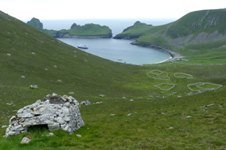
The previous reviews cover the 2 main ways of visiting St Kilda (Beyond having your own yacht!) – a day trip from Lewis and a longer (often c 1 week) small boat cruise of the area. In addition, however, there are a number of “Expedition Cruise” boats which take in the Islands as part of a larger (2 week) tour of UK islands or of the North Atlantic/Sub Arctic. We visited on one of the latter having set off the previous evening from Oban en route to Greenland. On arrival we were lucky to find a NW wind which left Village Bay reasonably well protected – our Zodiac landings at the little concrete pier were a bit bumpy but a planned cruise through the small gap between the islands of Hirta and Dun wasn’t possible with large Atlantic waves crashing through. The risk of not being able to land at St Kilda is high – the summer season day trips are scheduled on alternate days to provide a cushion against bad weather and you need to allow for delayed departures in your plans.
St Kilda is often stated to be the most remote island group on the British Isles ever to have been inhabited but in fact the island of North Rona is further from the nearest other land (c44 miles v 40). The latter (which our tour visited on the following day) contains early Christian remains dating back to 7th/8th century but lost its permanent population around 1844. St Kilda of course struggled on until the well known final evacuation in 1930
We spent around 4 hours on the main island of Hirta – enough time to explore the village and other remains of human settlement going back possibly to Neolithic times (including the unique “cleat” structures – photo), visit the museum and climb up to the highest point at Mullach Mor. We heard (but unfortunately didn’t manage to see) the “St Kilda Wren” subspecies. The equally unique “St Kilda Field Mouse” remained totally unnoticed! Soay sheep (“believed to be a survivor of the earliest domesticated sheep kept in northern Europe, and …. physically similar to the wild ancestors of domestic sheep, the Mediterranean mouflon and the horned urial sheep of Central Asia” Wiki) were, however, much in evidence. The buildings of the military radar base below the largely ruined village were somewhat larger than I had expected. They created something of a visual mess which could have created problems with inscription but ICOMOS dismissed them as making “relatively little impact on the landscape”. In fact continued military “occupation” is of great importance to the preservation of the island – without its infrastructure the Scottish National Trust would find it very difficult to maintain its current role. It is perhaps worth noting that St Kilda was originally inscribed in 1986 solely on 2 natural criteria (iii + iv) – despite the ICOMOS evaluation of that year concluding that it should also be inscribed on the basis of cultural criterion v (Quite why this didn’t happen is not really made clear in the minutes of the WHC). It then took until 2005 for cultural aspects to be added – with a deferral on these matters in 2004 at the same time as the site was increased in size with the inclusion of a massive marine area and the addition of a further natural criterion. We found the cultural aspects of interest partly for their intrinsic value but also because they brought to life those grainy black and white movies and stills of the final years and evacuation!
Our visit to Hirta was followed by a fine cruise (on our main vessel) around the stacs of Boreray a few miles to the NE - I don’t know if the standard “day trips” take it in. Stac an Armin is the highest stac in the British Isles, the location of enormous colonies of sea birds (including the largest gannet colony in the world) and the location of the killing of the last Great Auk in Great Britain. Boreray itself is the smallest UK island with a summit over 1000ft. Our captain gave us an exciting “figure of 8” trip through the small gaps between island and stacs with thousands of birds wheeling above us and waves crashing into the cliffs and sea caves around us. Bearing mind the original inscription criteria it would have been a shame to miss this “natural show” – but it too linked to the Cultural landscape since villagers used to climb those same stacs for birds, down and eggs. Amazing!
More on
Comments
No comments yet.
